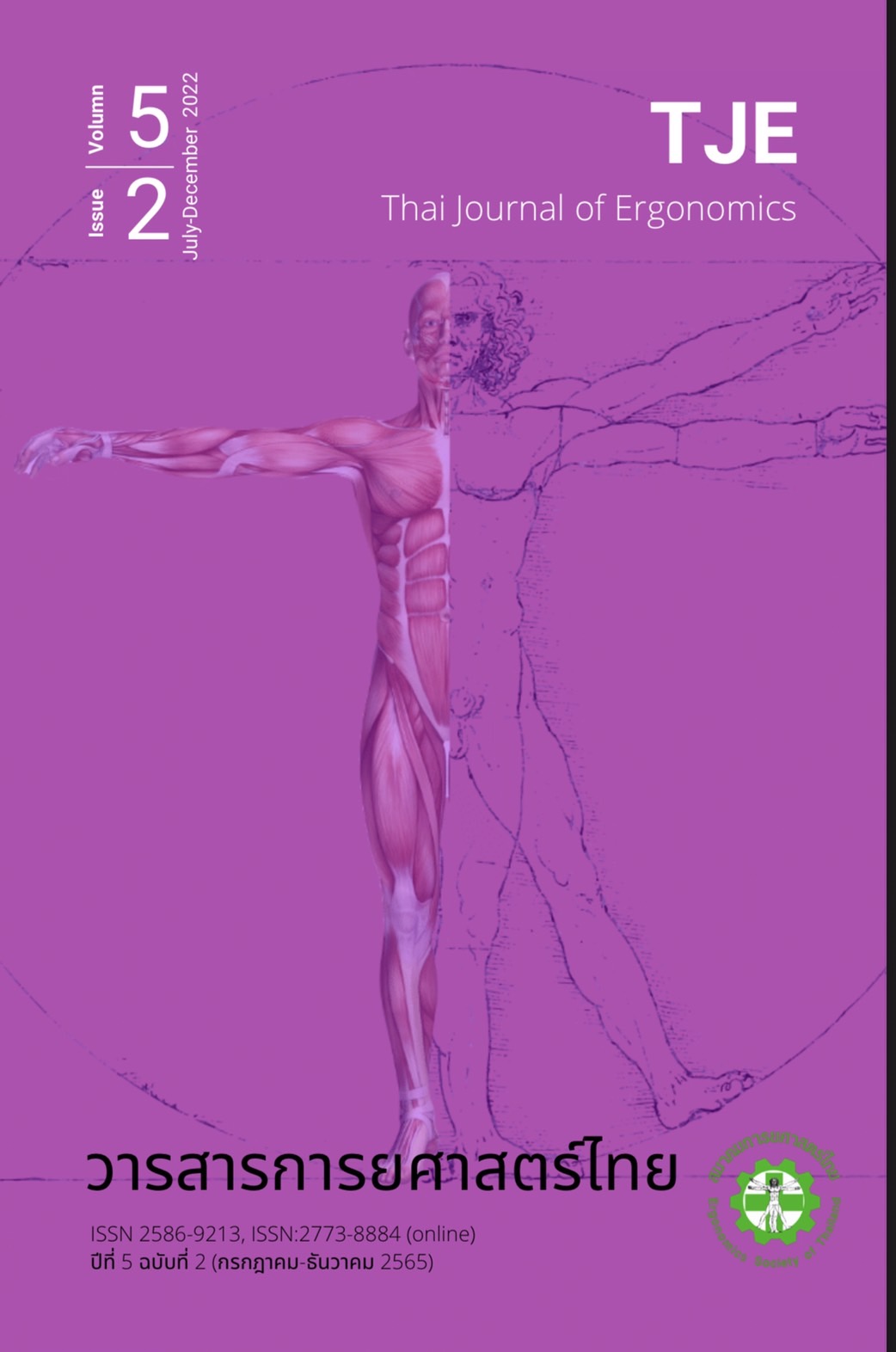Factors associated with eye pain and eye irritation during the online learning among the students of Faculty of Public Health, Thammasat University, Lampang Campus
Main Article Content
Abstract
During the COVID-19 pandemic, the online learning is required since crowded student limit per classroom was announced. The trends of computer or related devices using time for study are increasing among the students and resulted in vision abnormalities especially eye pain and eye irritation. This current research was aimed to investigate factors associated with eye pain and eye irritation during the online learning by analytical cross-sectional study among the students of Faculty of Public Health, Thammasat University, Lampang Campus. The self-reported questionnaire was administered to 132 students. Univariable and multivariable binary logistic regression were used to investigate the association. We found a high self-reported of eye pain (79.5%) and eye irritation (62.9%) among our subjects. The factors associated with eye pain were exercise (adjusted Odds Ratio (aOR) = 0.09, 95% Confidence Interval (95%CI): 0.02-0.42; p = 0.002) and sleep time (aOR = 12.80, 95%CI: 3.22-50.90; p = <0.001) by multivariable analysis. Meanwhile, the factors associated with eye irritation were age (aOR = 0.39, 95%CI: 0.16-0.92; p = 0.032), contact lens using (aOR = 18.26, 95%CI: 2.47-134.95; p = 0.004) and device time usage (aOR = 3.14, 95%CI: 1.33-7.45; p = 0.009) by multivariable analysis. Therefore, those associated factors with eye pain and eye irritation among students should be recognized and faculty or university could formulate the policy or recommendation to reduce such symptoms which could promote efficiency and safety online learning among students based on our results.
Article Details

This work is licensed under a Creative Commons Attribution-NonCommercial-NoDerivatives 4.0 International License.
References
นราพร ตรงดี, โชติกา อินทร์วัน, ศศินา โปรยทอง, จุฑามาศ แก้วล้อมกาย, ชลดา ดีป้อง, ณัฐกรณ์ ชูช่วย. อาการปวดเมื่อยและปัจจัยเสี่ยงของอาการปวดเมื่อยในช่วงการเรียนการสอนและการปฏิบัติงานในรูปแบบออนไลน์จากที่บ้านของนักศึกษาและบุคลากร คณะสาธารณสุขศาสตร์ มหาวิทยาลัยธรรมศาสตร์ ศูนย์ลำปาง. วารสารการยศาสตร์ไทย. 2564;4(1):47-57.
ชฎาภา ประเสริฐทรง, จรินวรรณ แสงหิรัญรัตนา, พรชนา กลัดแก้ว. ปัจจัยที่มีความสัมพันธ์กับความเครียดในการเรียนออนไลน์จากสถานการณ์โควิด-19 ของนักศึกษาพยาบาล. วารสารสถาบันจิตเวชศาสตร์สมเด็จเจ้าพระยา. 2021;15(1):14-28.
ปาจรา โพธิหัง, พรพรรณ ศรีโสภา, อโนชา ทัศนาธนชัย. ปัจจัยเสี่ยงของกลุ่มอาการจอภาพคอมพิวเตอร์ของบุคลากรสายการสอนในมหาวิทยาลัยบูรพา. วารสารการพยาบาลและการศึกษา. 2559;9(2):104-19.
สง่า ทับทิมหิน, นิตยา พุทธบุรี. ความชุกและระดับความรุนแรงของกลุ่มอาการทางตาจากจอภาพคอมพิวเตอร์ของบุคลากรสายสนับสนุนในมหาวิทยาลัยอุบลราชธานี. ศรีนครินทร์เวชสาร. 2562;34(2):173-7.
Assi L, Chamseddine F, Ibrahim P, Sabbagh H, Rosman L, Congdon N, et al. A global assessment of eye health and quality of life: a systematic review of systematic reviews. JAMA Ophthalmol. 2021;139(5):526-41.
Ranasinghe P, Wathurapatha WS, Perera YS, Lamabadusuriya DA, Kulatunga S, Jayawardana N, et al. Computer vision syndrome among computer office workers in a developing country: an evaluation of prevalence and risk factors. BMC Res Notes. 2016;9:150.
Zenbaba D, Sahiledengle B, Bonsa M, Tekalegn Y, Azanaw J, Kumar Chattu V. Prevalence of computer vision syndrome and associated factors among instructors in Ethiopian universities: a web-based cross-sectional study. Scientific World Journal. 2021;2021:3384332.
Patil A, Bhavya, Chaudhury S, Srivastava S. Eyeing computer vision syndrome: Awareness, knowledge, and its impact on sleep quality among medical students. Ind Psychiatry J. 2019;28(1):68-74.
Seresirikachorn K, Thiamthat W, Sriyuttagrai W, Soonthornworasiri N, Singhanetr P, Yudtanahiran N, et al. Effects of digital devices and online learning on computer vision syndrome in students during the COVID-19 era: an online questionnaire study. BMJ Paediatrics Open. 2022;6:e001429.
Altalhi A, Khayyat W, Khojah O, Alsalmi M, Almarzouki H. Computer vision syndrome among health sciences students in Saudi Arabia: prevalence and risk factors. Cureus. 2020;12(2):e7060.
Iyer JV, Lee SY, Tong L. The dry eye disease activity log study. Scientific World Journal. 2012;2012:589875.
Zayed HAM, Saied SM, Younis EA, Atlam SA. Digital eye strain: prevalence and associated factors among information technology professionals, Egypt. Environ Sci Pollut Res Int. 2021;28(20):25187-95.
Wangsan K, Upaphong P, Assavanopakun P, Sapbamrer R, Sirikul W, Kitro A, et al. Self-reported computer vision syndrome among Thai university students in virtual classrooms during the COVID-19 pandemic: prevalence and associated factors. Int J Environ Res Public Health. 2022; 19(7):3996.
Irawaty E, Rasyid M, Tirtasari S, Novendy N, Lontoh SO. A descriptive study about students’ symptoms and knowledge of computer vision syndrome. Muhammadiyah Medical Journal. 2021;2(2):41-8.
Wang L, Wei X, Deng Y. Computer vision syndrome during SARS-CoV-2 outbreak in university students: a comparison between online courses and classroom lectures. Front Public Health. 2021;9:696036.
Babu JV, Abraham S, Biju MJ, Jose J. Impact of digitalization in the eye strain during Covid-19 lockdown period: an epidemiological study. J Drug Deliv Ther. 2021;11(1-s):7-14.
Iqbal M, Elzembely H, Elmassry A, Elgharieb M, Assaf A, Ibrahim O, et al. Computer vision syndrome prevalence and ocular sequelae among medical students: a university-wide study on a marginalized visual security issue. The Open Ophthalmology Journal. 2021;15:156-70.
Simon C, Paul S. Prevalence and determinants of digital eye strain among school children during the COVID-19 pandemic. Int J Community Med Public Health. 2022;9(1):7-15.
Daniel WW, Cross CL. Biostatistics: a foundation of analysis in the health sciences. 10th ed. Hoboken, New Jersey: John Wiley & Sons, Inc; 2019.
Khan NH, Verma C, Gumustekin K, Ali H, Beg MMA, Osmonaliev K, et al. The assessment and impact of online classes among undergraduate medical student's during COVID-19 pandemic of the Republic of Kyrgyzstan - an online survey. Acta Sci Med Sci. 2022;2(2):86-91.
Joju A, Anthrayose CV, Puthiyedath R, Babu N, Rajan AR. Eyestrain and associated problems among undergraduate medical students undergoing e-learning/teaching methods during Covid-19 pandemic. Indian J Clin Exp Ophthalmol. 2021;7(2):308-13.
Shariat A, Cleland JA, Danaee M, Kargarfard M, Sangelaji B, Tamrin SBM. Effects of stretching exercise training and ergonomic modifications on musculoskeletal discomforts of office workers: a randomized controlled trial. Braz J Phys Ther. 2018;22(2):144-53.
Teo C, Giffard P, Johnston V, Treleaven J. Computer vision symptoms in people with and without neck pain. Appl Ergon. 2019;80:50-6.
Treleaven J, Takasaki H. Characteristics of visual disturbances reported by subjects with neck pain. Man Ther. 2014;19(3):203-7.
ศิวพร ภวสุปรีย์. การดูแลรักษา การใช้ และภาวะแทรกซ้อนของคอนแทคเลนส์ในวัยรุ่น จังหวัดอุทัยธานี. วารสารโรงพยาบาลมหาสารคาม. 2559;13(2):71-7.
Tauste A, Ronda E, Molina M-J, Seguí M. Effect of contact lens use on computer vision syndrome. Ophthalmic Physiol Opt. 2016;36(2):112-9.


